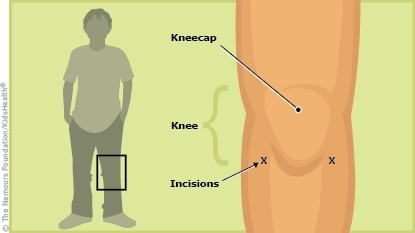Osteochondritis dissecans is a small area of damaged bone and cartilage (tissue that protects and supports bones) that can become loose or break away from the rest of the bone. Kids who have it usually have pain in the area, especially when they are active. If it's not treated, it can lead to continued pain, swelling, catching or locking of the joint, and sometimes arthritis (a condition that causes joint pain, swelling, and stiffness).
Your child has had surgery for osteochondritis dissecans. By following your surgeon's directions about resting the knee and going to physical therapy, your child should heal completely and be able to return to all of their usual activities within about six months.

Follow your surgeon's instructions for:
- How long your child needs to keep weight off the leg
- Wearing and caring for the brace or knee immobilizer
- Using crutches safely
- When it's OK to remove any bandages and how to clean and care for the incisions (surgery cuts)
- When it's OK for your child to take a bath or shower (usually 2–3 days after surgery)
- Keeping the incisions dry during bathing, for example by wrapping the knee in plastic wrap and sealing it at the top and bottom with tape
- When it's OK to put the knee fully under water (in a bath or pool)
- Any exercises or stretches your child should do
- When it's OK for your child to start adding activities and sports
- For older kids, when your child can drive again
- Going to physical therapy (PT)
- Returning for follow-up appointments
For pain and swelling:
- Give your child any medicines your surgeon recommends for pain. These may include prescription pain medicine, acetaminophen (Tylenol® or a store brand), or ibuprofen (Advil®, Motrin®, or a store brand). Some prescription pain medicines also include acetaminophen or ibuprofen. To avoid giving too much, give the medicines exactly as your surgeon recommends.
- Help your child get their mind off the pain by:
- Doing something they enjoy, like reading a book or watching a show together
- Listening to relaxing music
- Put ice in a plastic bag wrapped in a towel on the outside of the bandage, brace, or immobilizer for 20 minutes every 3 hours. Do not put ice directly on the skin, bandage, brace, or immobilizer.
- Use pillows to raise the leg when your child is sitting or lying down for the first few days after surgery.

Your child has:
- Chest pain or shortness of breath
- Calf pain or swelling that's getting worse
These can be signs of a blood clot, which is a very rare problem that can happen after surgery.

What happens during surgery for osteochondritis dissecans? The surgeon removes damaged tissue and attaches any bone or cartilage that has become loose back onto the bone.
When can someone return to activities after surgery for osteochondritis dissecans of the knee? It's important to be fully healed before returning to normal activities. Generally, this takes 6 months or longer.
Why do osteochondritis dissecans lesions of the knee happen? Osteochondritis dissecans lesions of the knee usually happen after an injury or when someone uses it too much for a sport and makes the same movements over and over. Genetic (inherited) factors can also play a role in whether a child develops an osteochondritis dissecans.




